Page 174 of 576
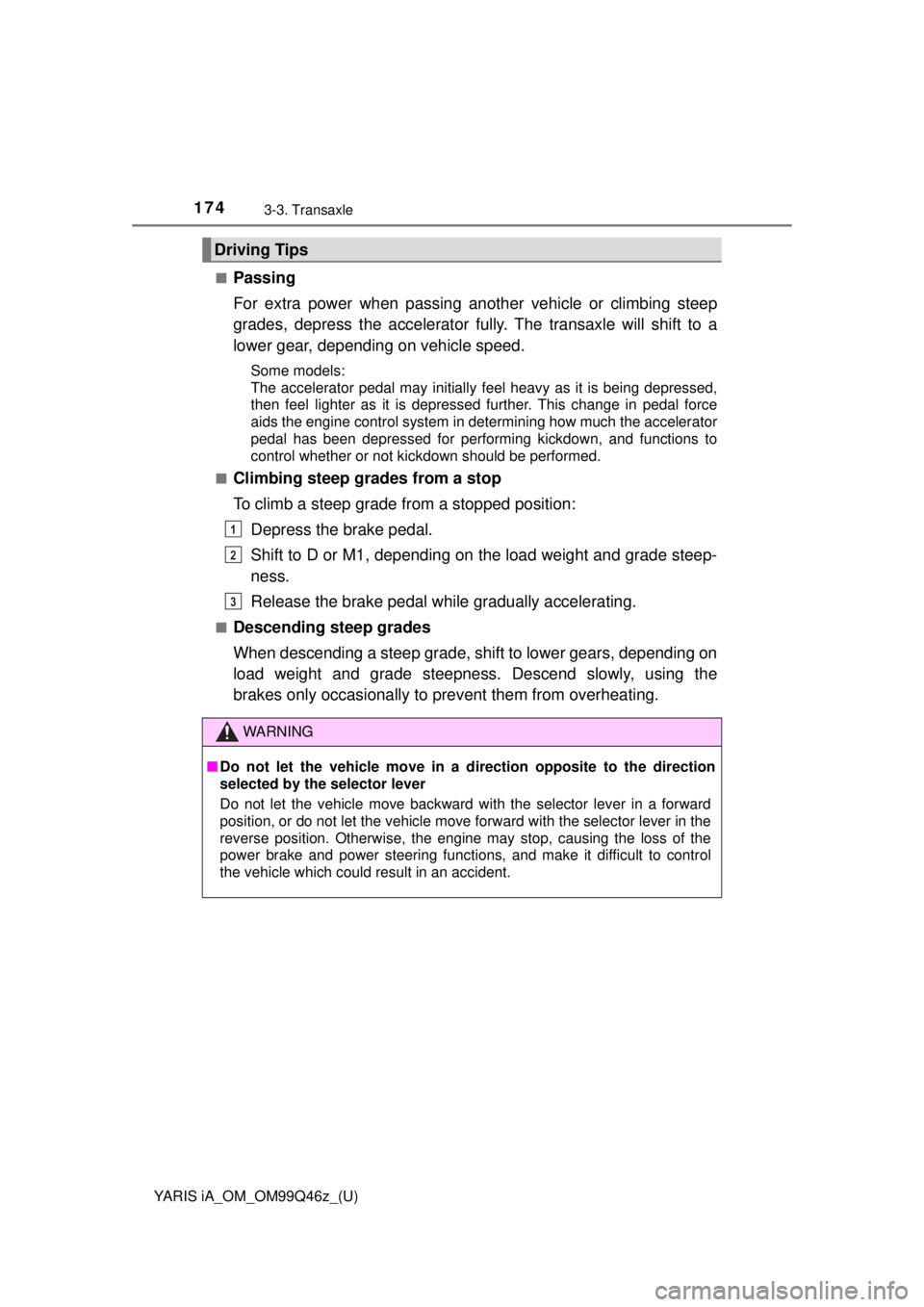
174
YARIS iA_OM_OM99Q46z_(U)
3-3. Transaxle
■Passing
For extra power when passing another vehicle or climbing steep
grades, depress the accelerator fully. The transaxle will shift to a
lower gear, depending on vehicle speed.
Some models:
The accelerator pedal may initially feel heavy as it is being depressed,
then feel lighter as it is depressed further. This change in pedal force
aids the engine control system in determining how much the accelerator
pedal has been depressed for performing kickdown, and functions to
control whether or not kickdown should be performed.
■
Climbing steep grades from a stop
To climb a steep grade from a stopped position:
Depress the brake pedal.
Shift to D or M1, depending on the load weight and grade steep-
ness.
Release the brake pedal while gradually accelerating.
■Descending steep grades
When descending a steep grade, shift to lower gears, depending on
load weight and grade steepness. Descend slowly, using the
brakes only occasionally to pr event them from overheating.
Driving Tips
WARNING
■Do not let the vehicle move in a di rection opposite to the direction
selected by the selector lever
Do not let the vehicle move backward with the selector lever in a forward
position, or do not let the vehicle move forward with the selector lever in the
reverse position. Otherwise, the engine may stop, causing the loss of the
power brake and power steering functions , and make it difficult to control
the vehicle which could result in an accident.
1
2
3
Page 186 of 576
186
YARIS iA_OM_OM99Q46z_(U)
3-4. Switches and Controls
Hazard Warning Flasher
The hazard warning lights warn
other drivers that your vehicle is a
traffic hazard and that they must
take extreme caution when near
it.
Depress the hazard warning
flasher and all the turn signals will
flash. The hazard warning indica-
tor lights in the combination meter
flash simultaneously.
●The turn signals do not work when the hazard warning lights are on.
● Check local regulations about the use of hazard warning lights while the
vehicle is being towed to verify that it is not in violation of the law.
The hazard warning lights should always be used when you stop
on or near a roadway in an emergency.
Page 187 of 576
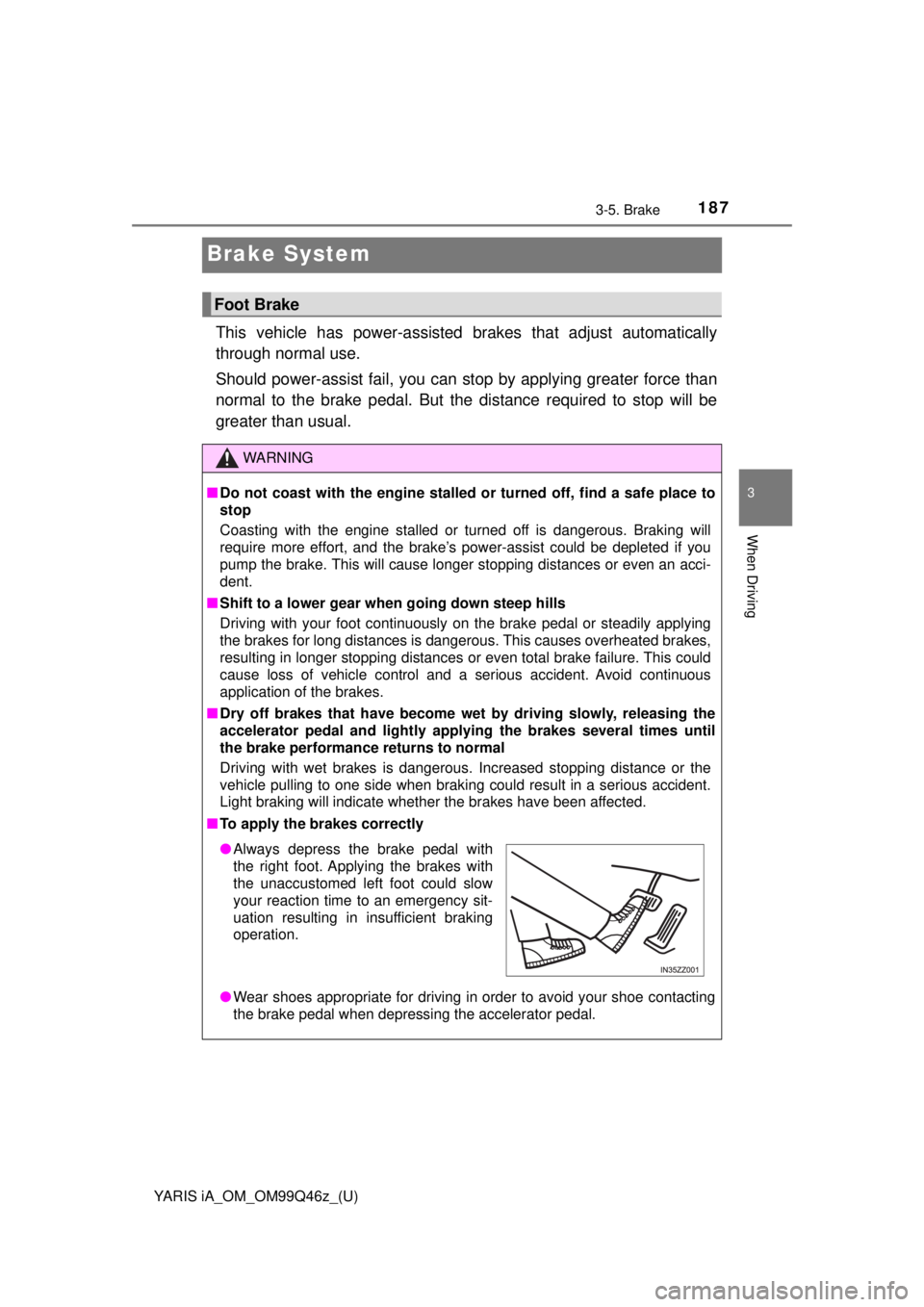
187
YARIS iA_OM_OM99Q46z_(U)
3-5. Brake
3
When Driving
Brake System
This vehicle has power-assisted brakes that adjust automatically
through normal use.
Should power-assist fail, you can st op by applying greater force than
normal to the brake pedal. But the distance required to stop will be
greater than usual.
Foot Brake
WARNING
■ Do not coast with the engine stalled or turned off, find a safe place to
stop
Coasting with the engine stalled or turned off is dangerous. Braking will
require more effort, and the brake’s power-assist could be depleted if you
pump the brake. This will cause longer stopping distances or even an acci-
dent.
■ Shift to a lower gear wh en going down steep hills
Driving with your foot continuously on the brake pedal or steadily applying
the brakes for long distances is dangerous. This causes overheated brakes,
resulting in longer stopping distances or even total brake failure. This could
cause loss of vehicle control and a serious accident. Avoid continuous
application of the brakes.
■ Dry off brakes that have become wet by driving slowly, releasing the
accelerator pedal and lightly applyi ng the brakes several times until
the brake performance returns to normal
Driving with wet brakes is dangerous. Increased stopping distance or the
vehicle pulling to one side when braking could result in a serious accident.
Light braking will indicate whether the brakes have been affected.
■ To apply the brakes correctly
● Wear shoes appropriate for driving in order to avoid your shoe contacting
the brake pedal when depressing the accelerator pedal.
●Always depress the brake pedal with
the right foot. Applying the brakes with
the unaccustomed left foot could slow
your reaction time to an emergency sit-
uation resulting in insufficient braking
operation.
Page 189 of 576
YARIS iA_OM_OM99Q46z_(U)
1893-5. Brake
3
When Driving
For parking in snow, refer to Winter Driving (→P. 130) regarding parking
brake use.
The warning light turns on when the system has a malfunction.
Refer to Warning Lights on P. 157.
When the disc brake pads
become worn, the built-in wear
indicators contact the disc plates.
This causes a screeching noise to
warn that the pads should be
replaced.
When you hear this noise, consult y our Toyota dealer as soon as pos-
sible.
NOTICE
Driving with the parking brake on will cause excessive wear of the brake
parts.
Warning Light
Brake Pad Wear Indicator
WARNING
■ Do not drive with worn disc pads
Driving with worn disc pads is dangerous. The brakes could fail and cause a
serious accident. As soon as you hear a screeching noise consult your
Toyota dealer.
Page 191 of 576
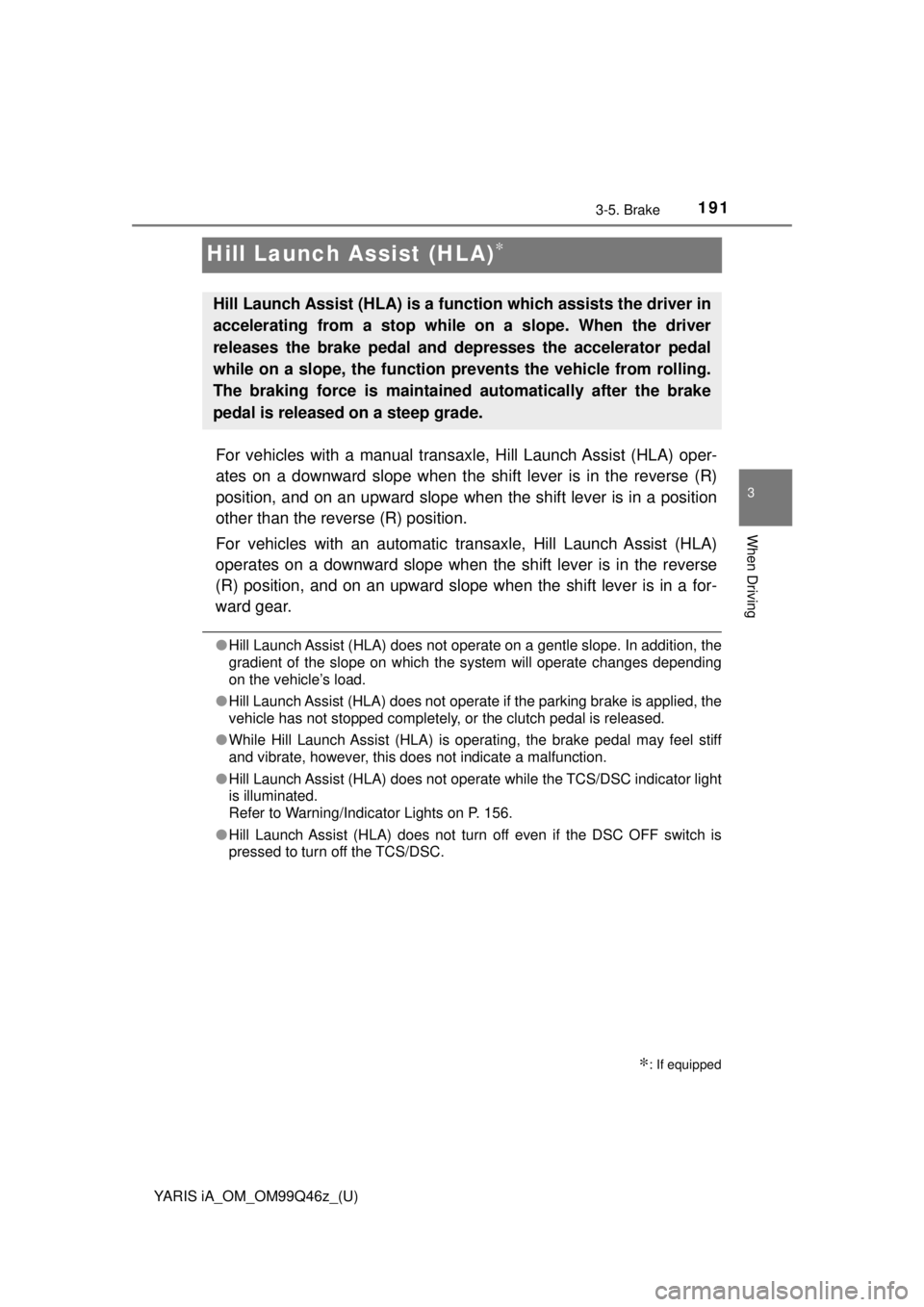
191
YARIS iA_OM_OM99Q46z_(U)
3-5. Brake
3
When Driving
Hill Launch Assist (HLA)∗
For vehicles with a manual transaxle, Hill Launch Assist (HLA) oper-
ates on a downward slope when the shift lever is in the reverse (R)
position, and on an upward slope when the shift lever is in a position
other than the reverse (R) position.
For vehicles with an automatic transaxle, Hill Launch Assist (HLA)
operates on a downward slope when the shift lever is in the reverse
(R) position, and on an upward slope when the shift lever is in a for-
ward gear.
● Hill Launch Assist (HLA) does not operate on a gentle slope. In addition, the
gradient of the slope on which the system will operate changes depending
on the vehicle’s load.
● Hill Launch Assist (HLA) does not operate if the parking brake is applied, the
vehicle has not stopped completely, or the clutch pedal is released.
● While Hill Launch Assist (HLA) is operating, the brake pedal may feel stiff
and vibrate, however, this does not indicate a malfunction.
● Hill Launch Assist (HLA) does not operate while the TCS/DSC indicator light
is illuminated.
Refer to Warning/Indicator Lights on P. 156.
● Hill Launch Assist (HLA) does not turn off even if the DSC OFF switch is
pressed to turn off the TCS/DSC.
∗: If equipped
Hill Launch Assist (HLA) is a function which assists the driver in
accelerating from a stop while on a slope. When the driver
releases the brake pedal and depresses the accelerator pedal
while on a slope, the function prevents the vehicle from rolling.
The braking force is maintained automatically after the brake
pedal is released on a steep grade.
Page 193 of 576
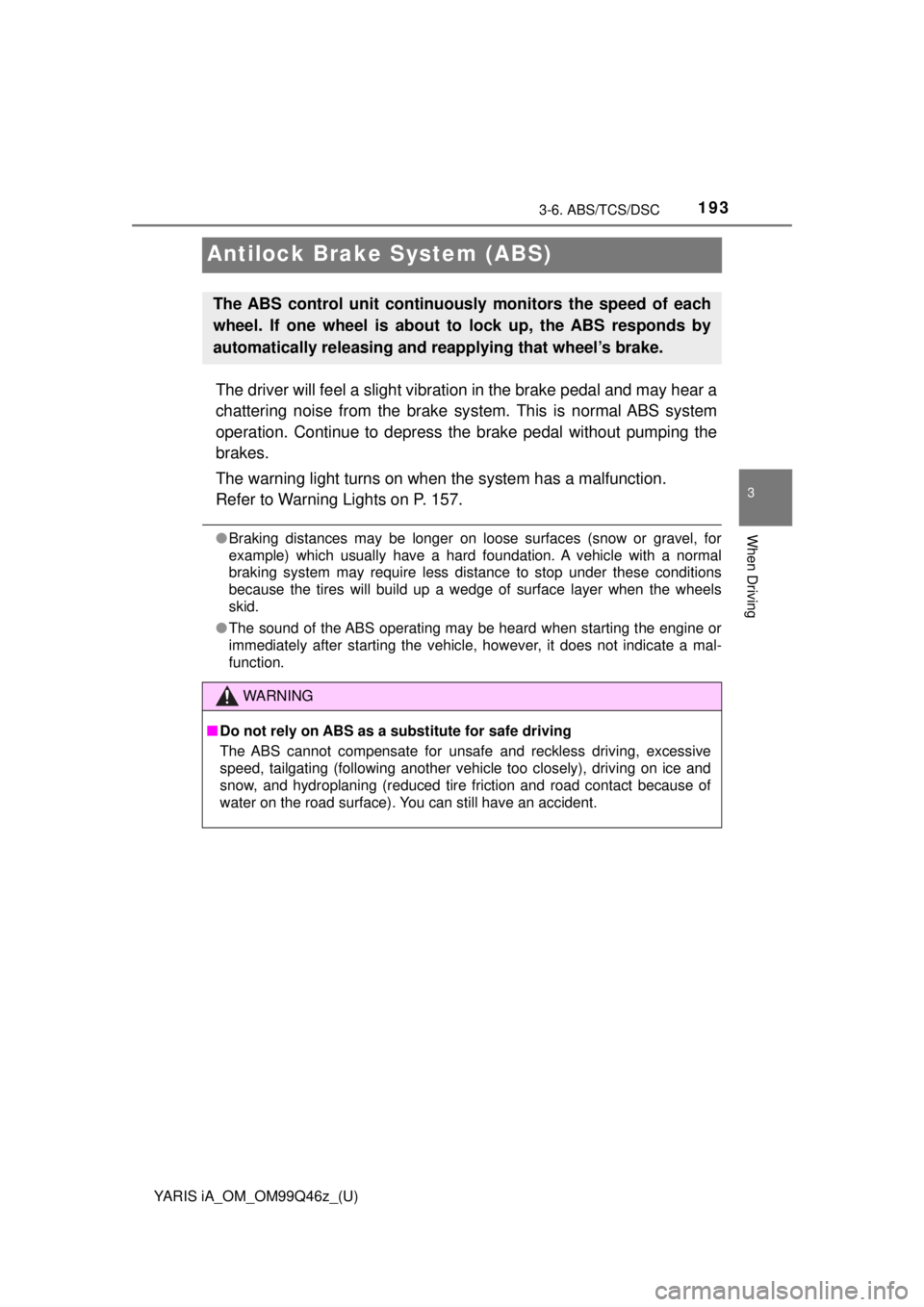
193
YARIS iA_OM_OM99Q46z_(U)
3-6. ABS/TCS/DSC
3
When Driving
Antilock Brake System (ABS)
The driver will feel a slight vibration in the brake pedal and may hear a
chattering noise from the brake system. This is normal ABS system
operation. Continue to depress the brake pedal without pumping the
brakes.
The warning light turns on when the system has a malfunction.
Refer to Warning Lights on P. 157.
● Braking distances may be longer on loose surfaces (snow or gravel, for
example) which usually have a hard foundation. A vehicle with a normal
braking system may require less distance to stop under these conditions
because the tires will build up a wedge of surface layer when the wheels\
skid.
● The sound of the ABS operating may be heard when starting the engine or
immediately after starting the vehicle, however, it does not indicate a mal-
function.
The ABS control unit continuously monitors the speed of each
wheel. If one wheel is about to lock up, the ABS responds by
automatically releasing and reapplying that wheel’s brake.
WARNING
■ Do not rely on ABS as a substitute for safe driving
The ABS cannot compensate for unsafe and reckless driving, excessive
speed, tailgating (following another vehicle too closely), driving on ic\
e and
snow, and hydroplaning (reduced tire friction and road contact because of
water on the road surface). You can still have an accident.
Page 194 of 576
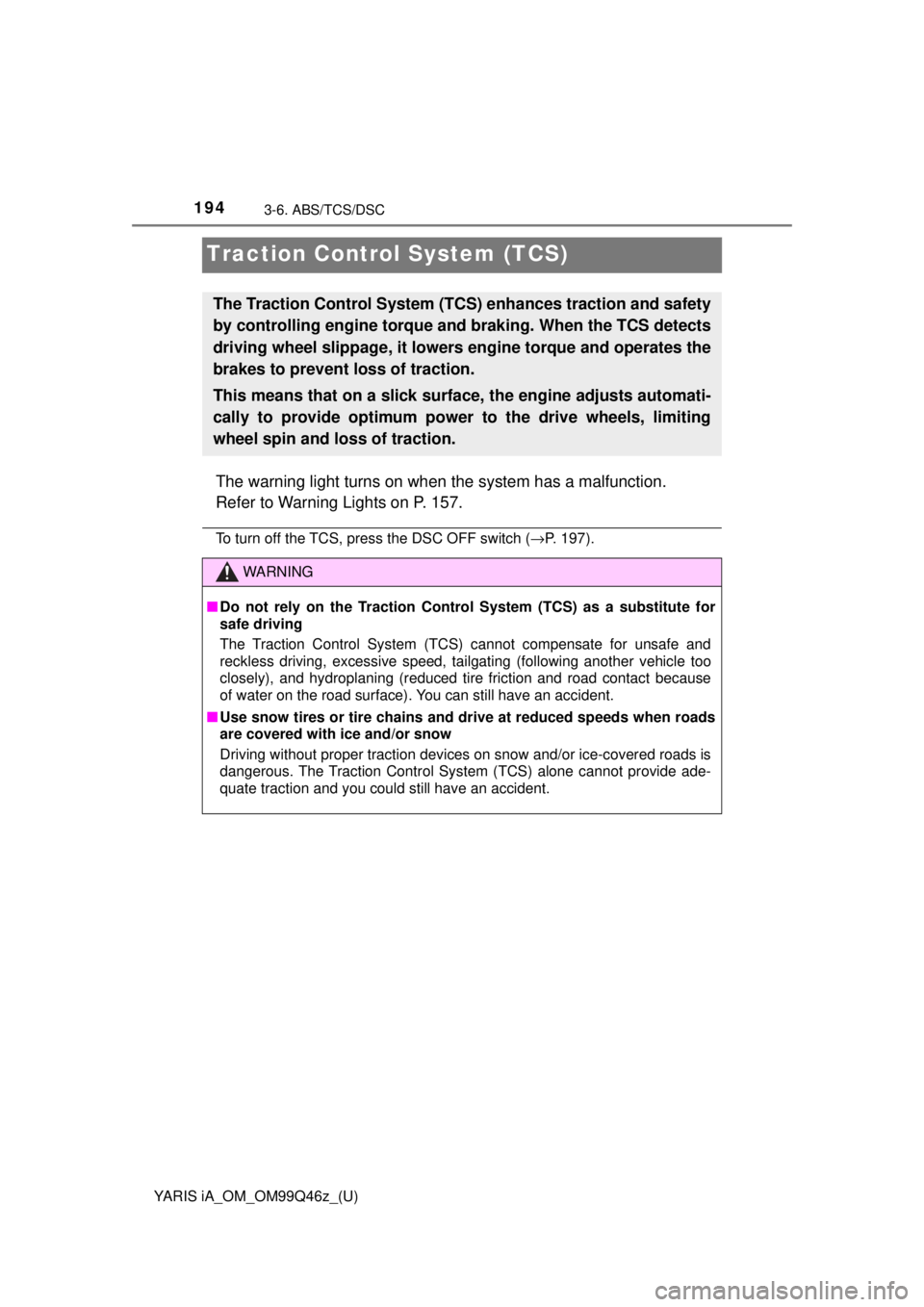
194
YARIS iA_OM_OM99Q46z_(U)
3-6. ABS/TCS/DSC
Traction Control System (TCS)
The warning light turns on when the system has a malfunction.
Refer to Warning Lights on P. 157.
To turn off the TCS, press the DSC OFF switch ( →P. 197).
The Traction Control System (TCS) enhances traction and safety
by controlling engine torque a nd braking. When the TCS detects
driving wheel slippage, it lowers engine torque and operates the
brakes to prevent loss of traction.
This means that on a slick surface, the engine adjusts automati-
cally to provide optimum power to the drive wheels, limiting
wheel spin and loss of traction.
WARNING
■ Do not rely on the Traction Control System (TCS) as a substitute for
safe driving
The Traction Control System (TCS) cannot compensate for unsafe and
reckless driving, excessive speed, tailgating (following another vehicle too
closely), and hydroplaning (reduced tire friction and road contact because
of water on the road surface). You can still have an accident.
■ Use snow tires or tire chains and drive at reduced speeds when roads
are covered with ice and/or snow
Driving without proper traction devices on snow and/or ice-covered roads is
dangerous. The Traction Control System (TCS) alone cannot provide ade-
quate traction and you could still have an accident.
Page 196 of 576
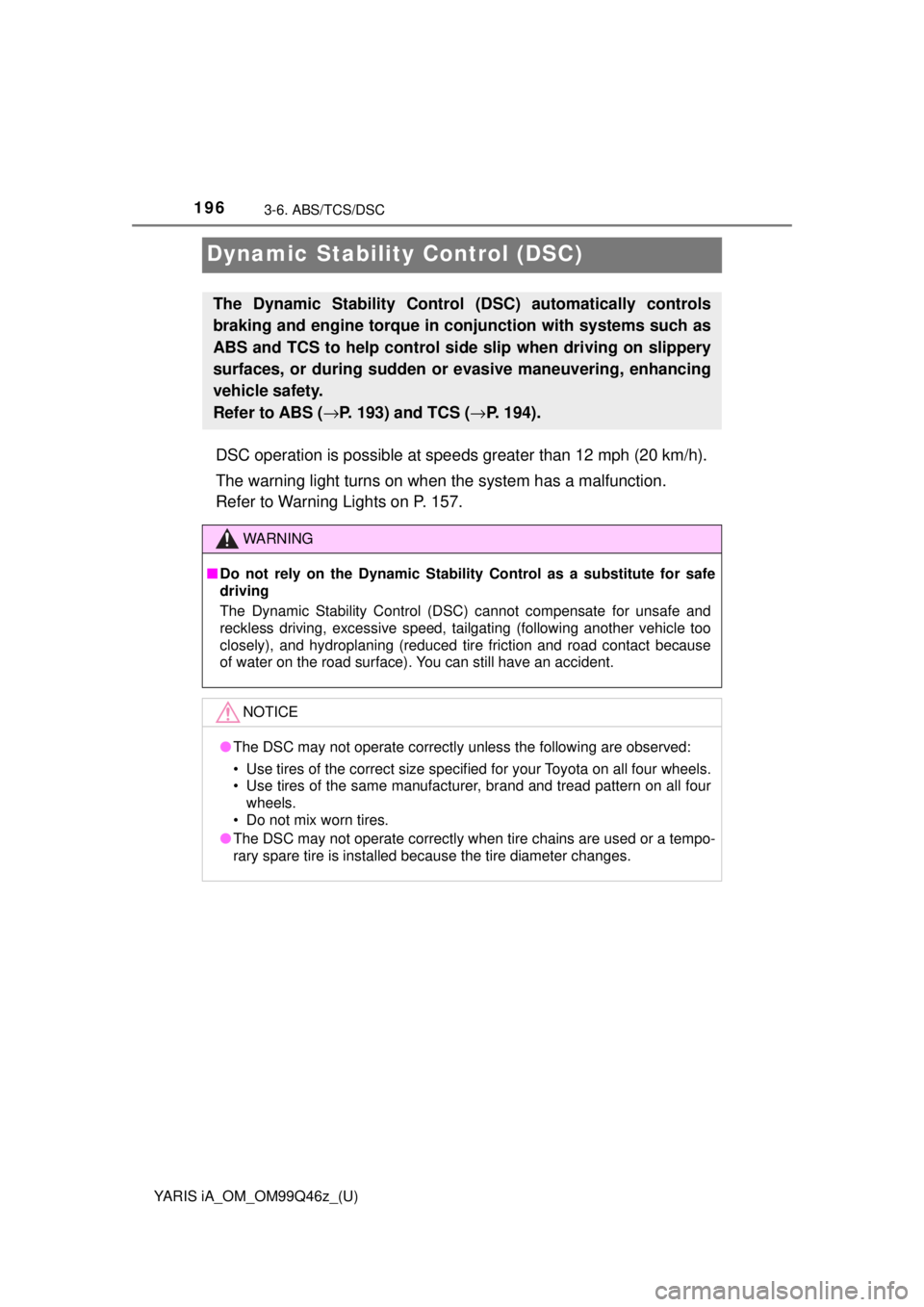
196
YARIS iA_OM_OM99Q46z_(U)
3-6. ABS/TCS/DSC
Dynamic Stability Control (DSC)
DSC operation is possible at speeds greater than 12 mph (20 km/h).
The warning light turns on when the system has a malfunction.
Refer to Warning Lights on P. 157.
The Dynamic Stability Control (DSC) automatically controls
braking and engine torque in conjunction with systems such as
ABS and TCS to help control side slip when driving on slippery
surfaces, or during sudden or e vasive maneuvering, enhancing
vehicle safety.
Refer to ABS ( →P. 193) and TCS ( →P. 194).
WARNING
■Do not rely on the Dynamic Stabilit y Control as a substitute for safe
driving
The Dynamic Stability Control (DSC) cannot compensate for unsafe and
reckless driving, excessive speed, tailgating (following another vehicle too
closely), and hydroplaning (reduced tire friction and road contact because
of water on the road surface). You can still have an accident.
NOTICE
● The DSC may not operate correctly unless the following are observed:
• Use tires of the correct size specif ied for your Toyota on all four wheels.
• Use tires of the same manufacturer, brand and tread pattern on all four wheels.
• Do not mix worn tires.
● The DSC may not operate correctly when tire chains are used or a tempo-
rary spare tire is installed because the tire diameter changes.